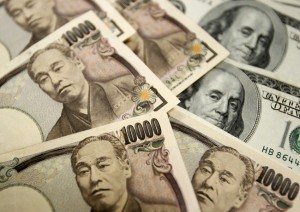 The yen declined against the US dollar on Tuesday after a report by BoJ showed progress in the central banks monetary stimulus, contrasting from the Federal Reserve policy, which is expected to end its bond-purchasing program at the end of the year.
The yen declined against the US dollar on Tuesday after a report by BoJ showed progress in the central banks monetary stimulus, contrasting from the Federal Reserve policy, which is expected to end its bond-purchasing program at the end of the year.
Having reached a session high at 104.62 at 03:40 GMT, USD/JPY traded at 104.36 at 09:11 GMT, adding 0.13% for the day. On January 2nd the pair touched 105.44, the strongest level since October 2008. Support was likely to be received at January 6th low, 103.92, the lowest since December 23rd, while resistance was to be encountered at January 6th high, 104.95. The pair settled last week 0.3% lower, the first weekly decline in 10 weeks.
The yen snapped yesterdays advance, which was the biggest in more than two months, after BoJ released a report on the nations monetary base. According to the data, the Japanese monetary base, which measures the supply of money by the central bank, surged by almost 47% in December from a year earlier, reaching a record of 193.5 trillion yen or $1.85 trillion. The Japanese central bank changed its policy target from interest rates to monetary base in April and is attempting to raise it to 270 trillion yen by the end of the year from December 2012.
“All the monetary easing that the BOJ had announced earlier last year seems to be on target for now,” said Divya Devesh, the Singapore-based foreign-exchange analyst at Standard Chartered Plc., cited by Bloomberg. She also added that: “There’s definitely a very strong monetary policy divergence, which will also be a very powerful driver of dollar-yen.”
The yen slid 18% last year on unprecedented monetary stimulus form the central bank of Japan. The currency remained under pressure amid speculation the BoJ will need to expand its stimulus program further in the coming months, if it wants to achieve the target of 2% inflation by late 2015.
Meanwhile, the US dollar came under pressure yesterday after a report by the Institute for Supply Management (ISM) revealed that activity in the US sector of services unexpectedly weakened in December. The corresponding non-manufacturing PMI fell to a reading of 53.0 last month from 53.9 in November, short of analysts’ projections of an increase to 54.5.
A separate report by the US Census Bureau showed that nation’s factory orders increased 1.8% in November on a monthly basis, following October’s 0.5% drop, while analysts had anticipated that the indicator will climb 1.7% in November.
Later in the day the United States is to report on its trade balance, with the median estimate by experts pointing to a lesser deficit figure, 40.000 billion USD in November, as a month ago nation’s deficit reached 40.641 billion USD.
Elsewhere, AUD/USD reached a daily low at 0.8912 at 5:05 GMT, after which consolidation followed at 0.8924, falling 0.49% for the day. Support was likely to be received at January 3rd low, 0.8885, while resistance was to be encountered at January 3rd high and also the highest point since December 12th, 0.9004.





